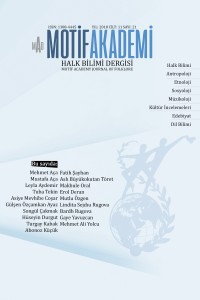PERFORMANCE, TRANSMISSION OF TWO-STRING CURA (RUZBA) AND THE PLACE AND IMPORTANCE OF ÂŞIK NESİMİ ÇİMEN IN THIS CONTEXT
Öz
In this study, structural characteristics and mode of
performance of the long-standing instrument which is mostly called two-string bağlama, two-string cura today and also known as ırızva and ruzba will be discussed. It is also aimed to emphasize the
important role of the instrument in the transmission and conservation of a
culture. For this, the role of Âşık Nesimi Çimen, one of the most important and
recent links in the process of bringing the two-string bağlama/cura to the present beyond the centuries has been
emphasized. In the study, literature review and structured interview methods
were used to collect data. In the study, it is seen that the ‘‘two-string’‘
instrument encountered in a poem of Kaygusuz Abdal in the 14th
century has been used in the Alevi belief and culture since then and is an
important part of it. Two-string bağlama/cura
which is performed with a unique tuning and playing technique is a dual sound
instrument consisting of two rows of string and played with tapping (clawing)
technique. Âşık Nesimi Çimen greatly served the transmission of two-string bağlama/cura from local to national,
from national to international with his studies. Nesimi performed the
two-string cura with the
technique developed by him and made this instrument known more with his
conscious efforts and also made efforts to prevent the disappearance of this
instrument. As a result, two-string bağlama/cura
has moved beyond being just an instrument, and has become one of the carrier
elements of a culture and survived until today.
Anahtar Kelimeler
Two-string Cura Nesimi’s instrument Ruzba Tune Şelpe (Tapping) Technique Alevi Music
Kaynakça
- BİRDOĞAN, Nejat (1988). Notalarıyla Türkülerimiz. İstanbul: Özgür Yayın Dağıtım.
- DURBİLMEZ, Bayram (2010). ‘‘Âşıklık Geleneklerinde Saz’‘. Millî Folklor, S. 85, 148-158.
- DUYGULU, Melih (2014). Türk Halk Müziği Sözlüğü. İstanbul: Pan Yayıncılık.
- EKİCİ, Savaş (1993). Ramazan Güngör ve Üç Telli Kopuzu. Ankara: Kültür Bakanlığı Halk Kültürlerini Araştırma ve Geliştirme Yayınları.
- GAZİMİHAL, Mahmut Ragıp (1975). Ülkelerde Kopuz ve Tezeneli Sazlarımız. Ankara: Ankara Üniversitesi Basımevi.
Öz
bir geçmişi olan ırızva, ruzba olarak da bilinen, günümüzde ise daha çok
ikitelli bağlama, ikitelli cura olarak tanımlanan çalgının yapısal özellikleri
ve icra biçimi ele alınacaktır. Aynı zamanda çalgının bir kültürün
aktarılmasındaki ve yaşatılmasındaki önemli payının vurgulanması amaçlanmıştır.
Bu süreçte ikitelli bağlama/curanın yüzyılları aşarak günümüze taşınmasında en
önemli ve en son halkalardan biri olan Âşık Nesimi Çimen’in rolü üzerinde
durulmuştur. Çalışmada, verilerin toplanmasında kaynak taraması ve yapılanmış
görüşme yöntemleri kullanılmıştır. Araştırmada, 14. yüzyılda Kaygusuz Abdal’ın
bir şiirinde rastlanılan ‘‘ikitelli’‘ sazın, o zamandan bu zamana Alevi inanç
ve kültüründe kullanılageldiği ve önemli bir parçası olduğu görülmüştür.
Kendine özgü bir düzen ve çalım tekniği ile icra edilen ikitelli bağlama/cura,
iki sıra telden oluşan ve şelpe (pençe) tekniği ile çalınan iki sesli bir
çalgıdır. İkitelli bağlama/curanın yerelden ulusala, ulusaldan uluslararasına
taşınmasında yaptığı çalışmalarla Âşık Nesimi Çimen’in büyük hizmetleri
olmuştur. İkitelli curanın çalım tekniğini kendine özgü, geliştirerek icra eden
Nesimi, bilinçli çabasıyla bu çalgının daha tanınır olmasını sağlarken aynı
zamanda yok olmasının da önüne geçmeye çalışmıştır. Sonuç olarak ikitelli
bağlama/cura, bir çalgı olmanın ötesine geçerek bir kültürün taşıyıcı
unsurlarından biri olmuş ve günümüze kadar yaşamış ve yaşatılmıştır.
Anahtar Kelimeler
Kaynakça
- BİRDOĞAN, Nejat (1988). Notalarıyla Türkülerimiz. İstanbul: Özgür Yayın Dağıtım.
- DURBİLMEZ, Bayram (2010). ‘‘Âşıklık Geleneklerinde Saz’‘. Millî Folklor, S. 85, 148-158.
- DUYGULU, Melih (2014). Türk Halk Müziği Sözlüğü. İstanbul: Pan Yayıncılık.
- EKİCİ, Savaş (1993). Ramazan Güngör ve Üç Telli Kopuzu. Ankara: Kültür Bakanlığı Halk Kültürlerini Araştırma ve Geliştirme Yayınları.
- GAZİMİHAL, Mahmut Ragıp (1975). Ülkelerde Kopuz ve Tezeneli Sazlarımız. Ankara: Ankara Üniversitesi Basımevi.
Ayrıntılar
| Birincil Dil | Türkçe |
|---|---|
| Konular | Sanat ve Edebiyat |
| Bölüm | Makaleler |
| Yazarlar | |
| Yayımlanma Tarihi | 22 Mart 2018 |
| Gönderilme Tarihi | 20 Şubat 2018 |
| Yayımlandığı Sayı | Yıl 2018 Cilt: 11 Sayı: 21 |



